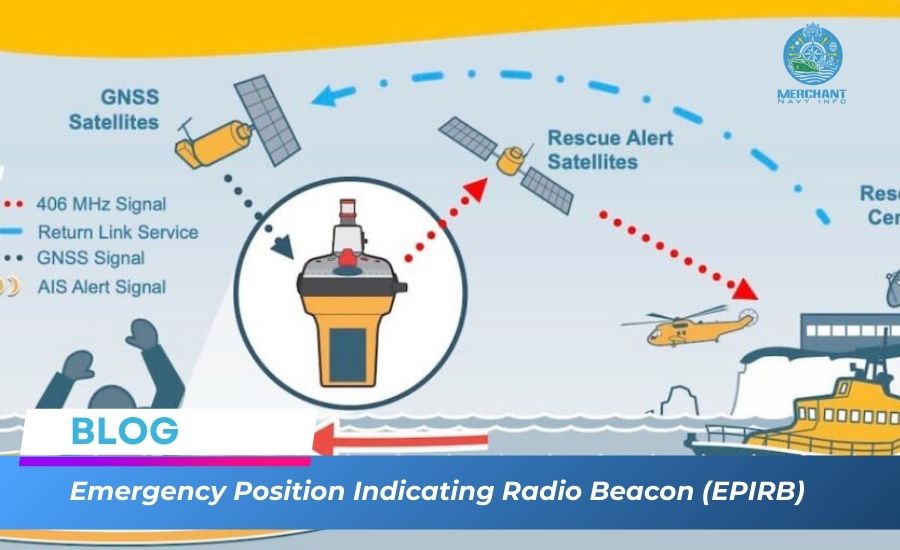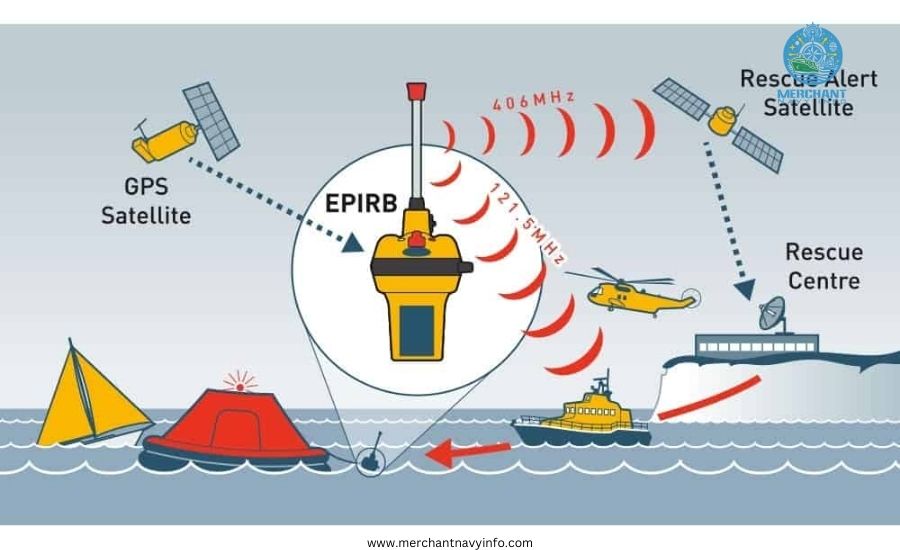
EPIRB: What does it mean?
An Emergency Identifier Beacon (EPIRB) alerts search and rescue services in the event of an emergency at sea. It is a tracking device that sends a signal to determine the location of a lifeboat, life raft, ship, or person in distress within a specific range.
An emergency locator is sometimes called a GPIRB, which stands for Emergency Locator with GPS Receiver, which can find your exact location faster.
What is an emergency locator used for?
An emergency locator is a distress alert device that, once activated, alerts the global search and rescue network to send help to your location as quickly as possible.
Emergency locators are installed on ships after they are registered with national search and rescue forces. The record allows false alarms to be confirmed and rescues to be conducted faster.
An emergency locator is a secondary means of emergency alert, meaning it is placed further down in the hierarchy to alert search and rescue authorities in distress.
Every ship must have one emergency locator on board, and all registered ships (and others) must have two.
When should an emergency locator be activated?
An emergency locator should only be activated in extreme danger or marine emergencies, such as a shipwreck or a medical emergency on board.

Different Types of Emergency Locator Devices
COSPAS-SARSAT – Emergency locators under the COSPAS-SARSAT system operate on the 406.025 MHz and 121.5 MHz bands and are suitable for all maritime areas
INMARSAT E—This emergency locator operates on the 1.6 GHz band and is suitable for use in maritime areas A1, A2, and A3.
VHF CH 70 – This device operates on the 156.525 MHz band and is suitable for use in maritime area A1 only.
Also Read: Emergency Medical Technician (EMT)
How does an emergency locator work?
The device contains two radio transmitters, one with 5 watts and the other with 0.25 watts. Each operates at 406 MHz, the international standard frequency for transmitting distress signals.
The 5-watt radio transmitter is synchronized with the GOES weather satellite orbiting the Earth in geosynchronous orbit.
COSPAS-SARSAT is an international satellite search and rescue system established by the United States, Russia, Canada, and France to detect emergency radio signals.
Due to the many advantages of 406 MHz beacons and the disadvantages of 121.5 MHz. The international Cospas-Sarsat program discontinued 121.5 MHz satellite processing on February 1, 2009. NOAA and the FAA encouraged the program to switch to 406 for obvious reasons.
However, aircraft may still use emergency locator transmitters and alerts from these devices will only be acted upon if confirmed by one or two other independent non-satellite sources or devices.

Emergency Locator Devices
The emergency locator transmits a signal to a satellite. The signal consists of an encrypted identification number (all in the form of a numeric code) that contains information such as the vessel’s identity, date of the incident, nature of the distress, emergency contacts, and location.
The unique identification number is programmed into each beacon at the factory. It consists of a 15-digit string of letters and numbers uniquely identifying the lighthouse. The number is on a white sticker on the lighthouse’s exterior. It is also called a hexadecimal ID.
The local user equipment (satellite receiver or ground station) calculates the victim’s location using the Doppler shift (the change in the frequency or wavelength of a wave (or other periodic event) that moves relative to its source by an observer).
The LUT sends a digital message to the MRCC (Rescue Mission Coordination Center), which is responsible for search and rescue operations and oversees the execution of rescue missions.
Also read: What Is Life Raft Drills? Essential Safety Practices
EPIRB
The geosynchronous satellites orbiting the Earth can only receive radio signals transmitted by radio if the EPIRB is not compatible with the GPS receiver. In this case, inferring the sender’s location or the owner’s identity is impossible.
These satellites can only pick up trace elements of these signals and can only give the approximate location of the EPIRB. According to international standards, the 406MHz signal is considered an emergency signal.
The signal can help you find the sender, even if they are 3 miles away. If the EPIRB is recorded, it is possible to identify a vessel or person in distress.
If the transmitter sends signals at a frequency of 121.5 MHz, rescuers or relevant personnel can find missing people even from 15 miles away. If the EPIRB also contains a GPS receiver, the accuracy of hitting the target can be improved.

Use GPS devices in emergencies.
Depending on the type and category of the GPS device and the situation, you can activate it manually or even automatically.
Class I auto-mounted devices can launch a GPS device when the GPS unit or hydrostatic launcher is submerged in water between 4 and 14 feet deep or 1.5 meters to 4 meters deep. This locator automatically launches and pops up in an emergency, alerting search and rescue operations.
Class II GPS devices must be manually activated by pressing a button. They are usually mounted above or below the deck.
Because GPS devices are designed to activate when submerged in water, they can accidentally activate if removed from the mount and come into contact with water, causing false alarms.
Class 3 GPS devices in New Zealand and Australia will not activate when submerged. They can only be operated manually.
Emergency locators must be activated to work, which can only happen when released from the mount. As mentioned earlier, this can be done manually or automatically. The device is mainly battery-powered, which is helpful because electricity is the first thing to be affected in a disaster.
When should the emergency GPS battery be replaced?
The emergency locator will mark the battery’s expiration date. However, it must be replaced every 2 to 5 years.
Emergency Locator Contains:
- 12 Volt Battery
- Transmission Capacity: 48 Hours
Various Brackets for Emergency Locators
Class I arcs automatically activate the emergency locator, while Class II arcs require manual activation.
Class I brackets have a water level controller that must be replaced every 24 months.
Both types of brackets are equipped with water sensors to prevent false alarms.
Both allow manual activation when the GPS is mounted, as its antenna is pointed toward the sky.
Class I brackets protect the emergency locator from extreme weather and the sun’s UV rays.
Read more: Navigating the World of Flotsam and Jetsam in Shipping
What is a false alarm?
The ship’s personnel may accidentally activate the emergency locator and give a false alarm. If this happens, the nearest coast station or rescue coordination centre must be notified immediately, and the alarm must be cancelled.
The cancellation notification must also be sent to the appropriate authorities (e.g., the Directorate General of Shipping for ships registered in India or sailing in Indian waters when the false alarm was sent). The ship’s owner and agent must also be notified. A radio beacon indicating the location of an emergency.
How to test an emergency GPS device?
The emergency locator should be tested monthly to ensure safe operation. The required procedure is as follows:
- Press and release the TEST button on the EPIRB
- The red LED on the EPIRB should flash once
- Within 30 seconds of pressing the button, the bright light, as well as the red light, should flash several times
- After 60 seconds of operation, the EPIRB will switch off
EPIRB Maintenance
The EPIRB should be visually inspected for any defects, such as cracks
It is recommended to clean the EPIRB with a dry cloth occasionally
The switch should be checked in particular when cleaning
The EPIRB rope should be neatly packed in the EPIRB container without any loose ends sticking out
The battery must be checked for expiry dates to cover the current trip and at least the next trip
If the EPIRB fails the monthly inspection, return the EPIRB to the service agent or supplier
Replace the battery on board if facilities are available, or send it to the service agent if no facilities are available
If a GPS device is used in an emergency, it must be returned to an authorized service agent for battery replacement.
If the GPS device expires, it must be replaced on board and marked with a two-year expiry date.
What does Return Link Service or RLS mean?
Return Link emergency locators have flashing blue LED lights, confirming that search and rescue have received the distress message and your exact location. The Return Link Service signal is transmitted via the Galileo satellite network.
Knowing they have been identified and help is on the way brings great comfort to those facing emergencies at sea.
Register
EPIRB Radio Beacon Records
- If you buy a new or used 406 MHz radio beacon, you can register your EPIRB with your local authority.
- You must update your beacon record if you change your mobile number, address, or other information.
- If you sell your radio, notify the local authorities so the buyer can register it. Otherwise, they may contact you if it is activated.
EPIRB Radio Beacon Registration Updates
For recreational boats, EPIRB radio signal registration and serial numbers must be updated every two years.
The records can be updated online, and you can also add flight details.
The more information you provide and the more often you update the log, the better you can provide rescuers with all the details they need to speed up rescue.

Is there a subscription fee for EPIRB?
Once you have an EPIRB or personal locator beacon, you don’t have to pay anything. Instead, if you turn on the radio, rescue is free in many countries.
Advantages of GPS radio beacons
Radio beacons with built-in GPS reduce the search radius to 100 meters and shorten the notification time from less than 60 minutes to 60 seconds.
If the radio signal contains GPS coordinates, the GEOSAR satellite alerts the search and rescue team in about two to three minutes.
The LEOSAR satellite is in a low orbit and notifies the search and rescue team of its position in about an hour.
Systems
Most vessels, including fishing, passenger, and commercial vessels, must carry radio beacons to locate victims. Some states require them to be carried on recreational vessels more than a certain distance from shore.
The International Maritime Organization regulates the transmission of radio signals to locate victims on ships in international waters, and many countries also apply IMO standards to ships in their waters.
Also Read: Maritime Mechanic: A Comprehensive Guide to Being an Engine Cadet
Difference between EPIRB, radio locator beacons and personal locator beacons (PLBs)
An EPIRB is a radio locator beacon for individual entities. It indicates a dangerous situation for people not close to emergency services. PLB act as radiolocation beacons and transmits on the COSPAS SARSAT satellite system at 406.025 MHz. They are much smaller than BPRLs and work worldwide, at sea and on land.
They should be stored in a safe place on board, in a survival bag or an easily accessible place. Some have powerful lights that can be activated manually or automatically.
Once activated, the transmission time of an EPIRB is at least 24 hours, while the battery life of an EPIRB is at least twice as long (at least 48 hours). BPRLs are registered to the ship’s name, while BPRLs are registered to the person’s name.
An EPIRB is essential emergency equipment in case of danger on board. Much time must be invested in caring for, testing, and maintaining it to perform at its best when a situation arises.









